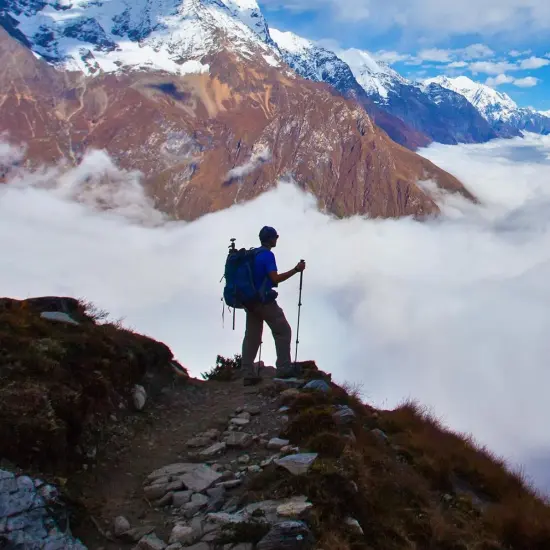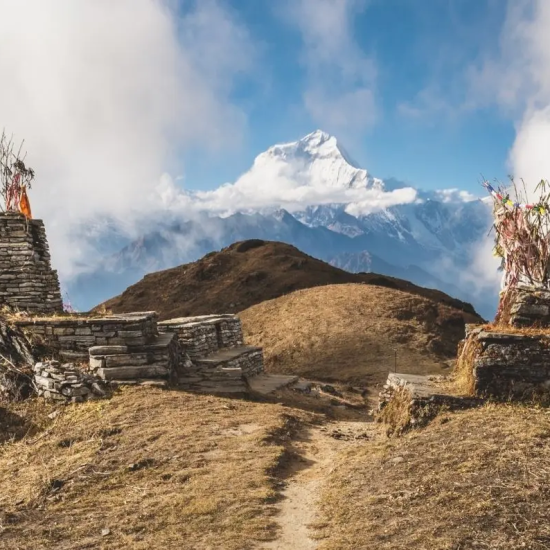The Everest Three Passes Trek is the ultimate trekking adventure in the Everest region, designed for those seeking a complete and challenging Himalayan experience. This exhilarating circuit takes you beyond Everest Base Camp and across three of the highest trekking passes in Nepal: Kongma La (5,535m), Cho La (5,420m), and Renjo La (5,360m).
Along the way, you’ll visit legendary destinations including Namche Bazaar, Tengboche Monastery, Everest Base Camp, Kala Patthar, Gokyo Lakes, and hidden Sherpa valleys less traveled by most trekkers.
Starting from Lukla, the trek follows the traditional Everest Base Camp route before branching off into remote alpine terrain. Each high pass offers a thrilling challenge and rewarding panoramic views of some of the world’s tallest peaks—Mt. Everest, Lhotse, Nuptse, Makalu, Ama Dablam, and Cho Oyu.
Whether you're a seasoned trekker or an ambitious adventurer, this trek delivers unmatched diversity in landscapes, culture, and high-altitude endurance. With expert guides, proper acclimatization days, and full support from our team at Places Nepal Treks, you’ll conquer the Three Passes with confidence.
Everything You Need to Know Before Doing the Everest Three High Passes Trek
The Everest Three High Passes Trek is one of the most challenging, scenic, and rewarding treks in the world. It’s more than just a journey to Everest Base Camp; it’s an immersive Himalayan circuit that crosses three high-altitude mountain passes over 5,000 meters: Kongma La (5,535m), Cho La (5,420m), and Renjo La (5,360m). This trek is ideal for experienced trekkers who are looking to push their limits while witnessing the full grandeur of the Everest region.
To make the most of this epic journey, it’s important to prepare not just for the trekking days, but also for all the logistics and considerations outside the itinerary. Here's everything you need to know before embarking on the Everest Three Passes Trek.
1. Getting to Nepal
Nepal is accessible by international flights through Tribhuvan International Airport (TIA) in Kathmandu. Major airlines from the Middle East, South Asia, and East Asia operate flights to Kathmandu. Ensure your passport is valid for at least six months from the date of entry.
Visa Information
Most travelers can obtain a visa on arrival at TIA. You’ll need:
A passport-sized photo
Valid passport
Cash (USD, EUR, or NPR) for visa fees: USD 30 (15 days), USD 50 (30 days), or USD 125 (90 days)
You can also apply for an e-Visa online in advance via the Nepal Immigration website.
2. Traveling to Lukla
Flights to Lukla, the starting point of the trek, operate from Manthali Airport (Ramechhap) during peak seasons (March–May & September–November) due to congestion at Kathmandu Airport. Manthali is a 5–6 hour drive from Kathmandu. During the off-season (winter and monsoon), flights may operate directly from Kathmandu to Lukla.
Helicopter options are available year-round from Kathmandu to Lukla for an additional fee and are ideal for avoiding road travel.
3. Physical Preparation and Acclimatization
The Everest Three Passes Trek is strenuous, involving long walking days, high altitudes, and extreme weather changes.
Key tips:
Begin physical training at least 2–3 months in advance
Focus on cardio, endurance, leg strength, and altitude adaptation
Include day hikes with a backpack
Acclimatization days are crucial—follow the rule: "climb high, sleep low"
4. Permits Required
You will need the following permits:
Places Nepal will arrange these for you.
5. Accommodation and Meals
During the trek, you’ll stay in tea houses, which are local lodges offering basic facilities. Expect twin-sharing rooms with communal dining areas. Bathrooms may be shared, and hot showers usually cost extra.
Meals typically include:
Breakfast: Toast, pancakes, porridge, eggs
Lunch/Dinner: Dal Bhat (lentil soup with rice), noodles, potatoes, pasta, and momos
Tea and instant coffee are widely available. Filtered or boiled water is recommended.
6. Packing Essentials
Packing smart is critical for a successful high-altitude trek. Essentials include:
Down jacket and sleeping bag (–10°C or lower)
Base layers, fleece, trekking pants, waterproof shell
Warm gloves, hat, and thermal socks
UV sunglasses, sunscreen, lip balm
Water bottles + purification tablets
Headlamp, trekking poles, daypack, duffel bag (provided by many companies)
Gear Rental in Kathmandu
If you’re missing any essential trekking equipment, don’t worry—Kathmandu has many gear rental shops offering affordable, quality items. You can rent everything from down jackets and sleeping bags to trekking poles and crampons.
7. Best Seasons to Trek
The best times for the Everest Three Passes Trek are:
Spring (March to May): Stable weather, rhododendron blooms, clear views
Autumn (September to November): Crisp air, post-monsoon clarity, vibrant landscapes
Avoid the monsoon season (June to August) due to heavy rains and slippery trails. Winter (December to February) can be extremely cold, and snow may block some high passes.
8. Altitude Sickness & Safety
High altitude is the greatest challenge of the Three Passes Trek. The key to prevention:
Ascend gradually with rest days
Drink 3–4 liters of water daily
Avoid alcohol and smoking
Recognize symptoms early: headache, nausea, dizziness
Medications like Diamox can aid acclimatization
Our trekking guides carry a pulse oximeter, first aid kit, and are trained to handle AMS (Acute Mountain Sickness).
9. Trekking with a Guide and Porter
Hiring a licensed trekking guide and porter enhances safety, cultural insight, and your overall experience. The Three Passes route includes remote sections and challenging terrain, where having an experienced guide is crucial.
Places Nepal Treks provides professional, English-speaking guides, one porter for every two trekkers, and full logistical support throughout the trek.
10. Connectivity and Power
Internet: Wi-Fi is available in many tea houses (often at a small charge), but expect slow connections at high altitudes.
Electricity: Most lodges offer charging at a fee. Carry a power bank and solar charger.
Mobile network: Ncell and NTC have limited coverage. Purchase a local SIM in Kathmandu if needed.
11. Travel Insurance
Travel insurance is mandatory for high-altitude trekking in Nepal. Your policy must cover:
Bring a digital and printed copy of your policy for reference.
The Everest Three High Passes Trek is a life-changing journey that combines physical endurance, breathtaking landscapes, and cultural encounters. With proper preparation, a reliable outfitter, and respect for the mountains, this circuit offers the ultimate Himalayan experience.







































































